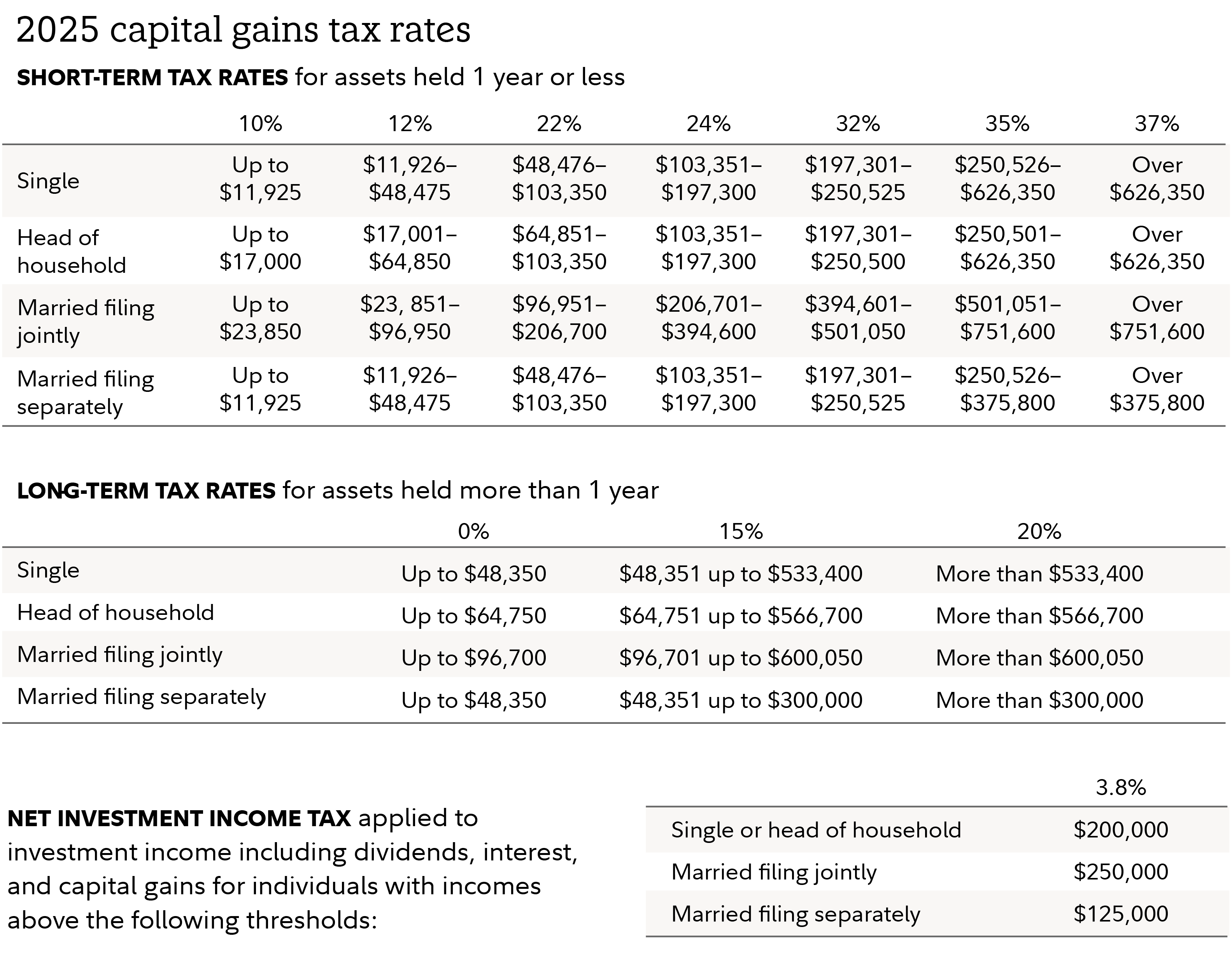If you actively trade, you may know how to find new ideas and act on them. But are you considering the impact of taxes on your strategy and your returns?
Of course, you should never make trading or investing decisions based solely on potential tax consequences. Those should be driven primarily by your goals, financial situation, timeline, risk tolerance, and any other factors specific to your situation—including your risk and return expectations for each trade. But as part of your overall trading strategy, better tax awareness does have the potential to improve your after-tax returns.
With that in mind, here are 4 tips on taxes to think about when trading the market.
Know the different tax rates for capital gains
When it comes to trading and taxes, timing matters. Trading strategies are often short term in duration (such as day trading strategies). So you'll want to take into account the relatively higher tax rates associated with short-term capital gains versus long-term capital gains.
Investments held for more than 12 months before being sold are taxed as long-term gains or losses, with a top federal rate of 20%. That compares with investments held for 12 months or less before being sold having a top federal tax rate of 37%. For high-income earners, an additional 3.8% Net investment income tax may apply in either case. The tables below show the difference in tax rates for short- and long-term capital gains rates at various taxable income levels (after adjustments to income and deductions, like the standard deduction, are applied).

In addition to capital gains, remember that dividends are also taxed—if you end up owning a stock when it pays a dividend. Ordinary dividends are taxable as ordinary income, while qualified dividends that meet certain requirements are taxed at lower capital gains rates.
For nontraditional investments, such as cryptocurrency, taxation policy may be subject to change. In 2014, the IRS issued Notice 2014-21, which states that virtual currencies would be treated as property. This distinction is important because personal property is subject to capital gains tax rates, whereas trading of currency is generally subject to ordinary tax rates. As always, consult your tax advisor if you have specific tax questions.
Understand your cost basis
If you sell an investment for more than the original purchase price (plus any adjustments), the difference is taxable as a capital gain. For tax purposes, your cost basis is determined by the price you paid to purchase a stock or other investment, plus any additional adjustments—such as transaction costs like broker's fees or commissions. There are 2 general ways to calculate cost basis: actual cost method and average cost method.
- Actual cost method – This method is commonly used for stock and other equity trades, and is likely the most familiar to traders. As the name suggests, your cost basis is the actual purchase price of each share and you'll need to know that in order to use this method. This may get complicated if you bought shares at different prices and are not exactly sure which shares were sold first. At Fidelity, for example, first in, first out (FIFO) is used to determine cost basis by default when selling individual securities, such as stocks and bonds. Assume a hypothetical trader owned 200 shares of a stock. The first 100 were purchased at $10 per share, the next 50 at $15, and the final 50 at $20 per share. If the trader sold 125 shares, using FIFO the first 100 shares sold will come from the first lot and the remaining 25 from the second lot. This helps keep track of exactly which shares were sold and as a result, helps simplify cost basis calculations.
- Average cost method – This method is more commonly used for mutual funds. It takes the total cost of the shares and divides it by the number of shares in the fund. For example, if you bought 3 shares of a mutual fund at $50, $100, and $150, the average cost method will result in a cost basis of $100 ([$50 + $100 + $150] / 3).
Harvest losses, but beware of wash sales
Tax-loss harvesting allows you to sell investments that are down, replace them with reasonably similar investments, and then offset realized investment gains with those losses. Essentially, tax-loss harvesting allows you to offset your capital gains with losses if you have investments where you have a loss (i.e., the current price is below the purchase price). This strategy may help you reduce your tax bill.
Let's look at a hypothetical example. Suppose you own a consumer staples stock whose current price is below your cost basis, and while you're not convinced that it will come back over the short term, you still believe in the long-term prospects for all or some part of the consumer staples sector.
If you have realized gains in other parts of your portfolio, you might consider selling the stock and replacing it with a consumer staples ETF. You could choose a broad consumer staples sector ETF, or you might opt instead for a more narrowly focused consumer staples industry ETF if you'd like to focus on a particular segment of the consumer staples sector—such as household products, food products, or personal products.
If your realized losses exceed your realized gains, you can deduct up to $3,000 ($1,500 for married individuals filing separately) of your total realized losses from ordinary income. In some cases, if your realized gains and your realized losses exceed the limits for ordinary income deductions in the year they occur, the tax losses can be "carried forward" to offset future realized investment gains.
Harvesting these losses to offset taxes on profitable trades can be an effective way to cut capital gains taxes. But be sure to comply with IRS rules on wash sales. The wash-sale rule generally states that your tax loss will be disallowed if you buy the same security, a contract or option to buy the security, or a substantially identical security within 30 days of the date you sold the loss-generating investment. If you run afoul of the wash-sale rule, you won't be able to use those losses to offset other gains or income.
Utilize tax-advantaged accounts
Many traders mistakenly think they can only execute trading strategies in individual brokerage accounts that are not tax-advantaged. In fact, it may make sense to execute some trading strategies in tax-advantaged accounts. If you trade options, you can do a variety of strategies in an IRA, for example, including buy calls and puts, sell covered calls, and more. Capital gains taxes can be deferred in IRAs and some other retirement accounts to help your money grow over time.
When you review the potential tax impact of your investments, consider locating and holding investments that generate certain types of taxable distributions within a tax-advantaged account rather than a taxable account. With that said, excessive trading in a retirement account can undermine your long-term goals, so make sure you have a solid plan that aligns with your overall objectives and risk tolerance.


